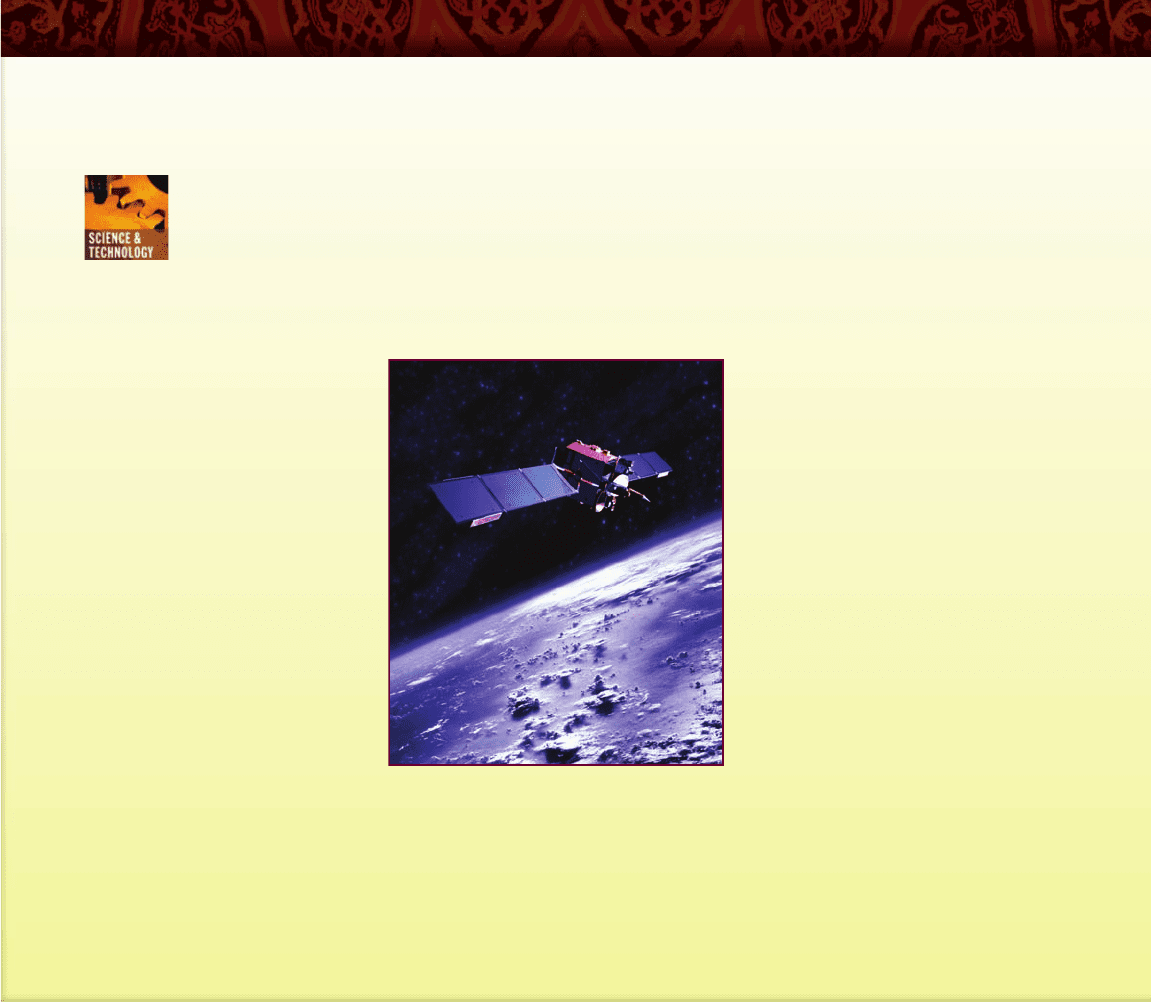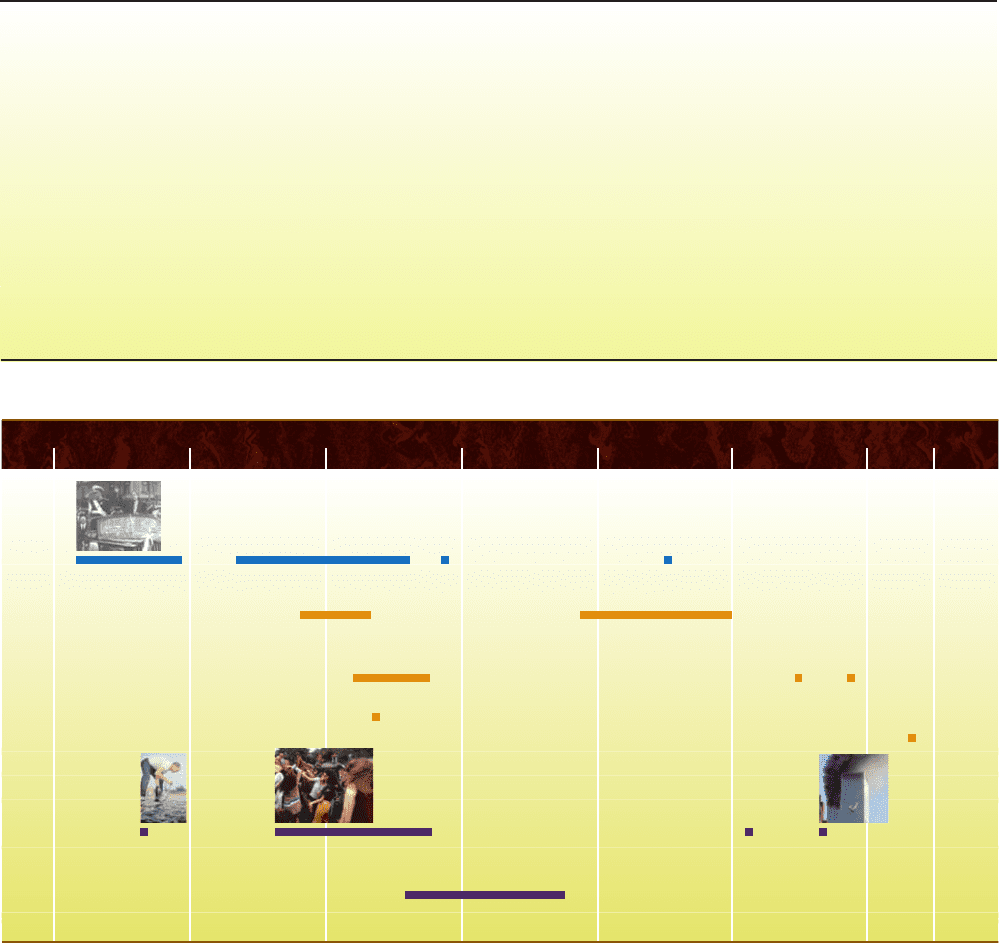Duiker W.J., Spielvogel J.J. The Essential World History. Volume 2: Since 1500
Подождите немного. Документ загружается.


I feel nearer, more a part of the painting, since this way I
can walk around it, work from four sides and be literally
in the painting. When I am in the painting, I am not
aware of what I am doing. There is pure harmony.’’
Postmodernism’s eclectric commingling of past tra-
dition with Modernist innovation became increasingly
evident in architecture. Robert Venturi argued that ar-
chitects should look as much to the commercial strips of
Las Vegas as to the historical styles of the past for inspi-
ration. One example is provided by Charles Moore. His
Piazza d’Italia (1976--1980) in New Orleans is an outdoor
plaza that combines Classical Roman columns with
stainless steel and neon lights. This blending of modern-
day materials with historical references distinguished the
Postmodern architecture of the late 1970s and 1980s from
the Modernist glass box.
Throughout the 1980s and 1990s, the ar t and music
industries increasingly adopted the techniques of mar-
keting and advertising. With large sums of money in-
vested in painters and musicians, pressure mounted to
achieve critical and commercial success. Negotiating the
distinction between art and popular culture was es-
sential since many equated merit w ith sales or economic
value.
In the art world, Neo-Expressionism reached its
zenith in the mid-1980s. Neo-Expressionist artists like
Anselm Kiefer became increasingly popular as the art
market soared. Born in Germany in 1945, Kiefer com-
bines aspects of Abstract Expressionism, collage, and
German Expressionism to create works that are stark and
haunting. His Departure from Egypt (1984) is a medita-
tion on Jewish history and its descent into the horrors of
Nazism. Kiefer hoped that a portrayal of Germany’s
atrocities could free Germans from their past and bring
some good out of evil.
The World of Science and Technology
Many of the scientific and technological achievements
since World War II have revolutionized people’s lives.
During World War II, university scientists were re-
cruited to work for their governments and develop new
weapons and practical instruments of war. British
physicists played a crucial role in the development of an
improved radar system that helped defeat the German
air force in the Battle of Britain in 1940. German sci-
entists created self-propelled rockets as well as jet air-
planes to keep Hitler’s hopes alive for a miraculous
turnaround in the war. The computer, too, was a war-
time creation. The British mathematician Alan Turing
designed a primitive computer to assist British intelli-
gence in breaking the secret codes of German ciphering
machines. The most famous product of wartime sci-
entific research was the atomic bomb, created by a team
of American and European scientists under the guid-
ance of the physicist J. Robert Oppenheimer. Although
most war time devices were created f or destructive
purposes, they could easily be adapted for peacetime
uses.
The postwar alliance of science and technology led to
an accelerated rate of change that became a fact of life in
Western society (see the comparative essay ‘‘From the
Industrial Age to the Technological Age’’ on p. 717). One
product of this alliance---the computer---may yet prove to
be the most revolutionary of all the technological in-
ventions of the twentieth century. Early computers, which
required thousands of vacuum tubes to function, were
large and hot and took up considerable space. The de-
velopment of the transistor and then the silicon chip
Jackson Pollock at Work. One of the best-known practitioners of
Abstract Expressionism, which remained at the center of the artistic
mainstream after World War II, was the American Jackson Pollock, who
achieved his ideal of total abstraction in his drip paintings. He is shown here
at work at his Long Island studio. Pollock found it easier to cover his large
canvases with exploding patterns of color when he put them on the floor.
c
Hans Namuth/Photo Researchers, Inc.
716 CHAPTER 28 EUROPE AND THE WESTERN HEMISPHERE SINCE 1945

produced a revolutionary new approach to computer
design. With the invention in 1971 of the microprocessor,
a machine that combines the equivalent of thousands of
transistors on a single, tiny silicon chip, the road was
open for the development of the personal computer. By
the 1990s, the personal computer had become a regular
fixture in businesses, schools, and homes. The Internet---
the world’s largest computer network---provides people
around the world with quick access to immense quanti-
ties of information, as well as rapid communication and
commercial transactions. As of 2010, estimates are that
more than a billion people worldwide are using the
Internet.
Despite the marvels produced by science and tech-
nology, some people have come to question their un-
derlying assumption---that scientific knowledge gives
human beings the ability to manipulate the environment
for their benefit. They maintain that some technological
advances have far-reaching side effects that are damaging
to the environment. Chemical fertilizers, for example,
once touted for producing larger crops, have wreaked
havoc with the ecological balance of streams, rivers, and
woodlands. Small Is Beautiful, written by the British
economist E. F. Schumacher (1911--1977), is a funda-
mental critique of the dangers of the new science and
technology (see the box on p. 718).
COMPARATIVE ESSAY
F
ROM THE INDUSTRIAL AGE TO THE TECHNOLOGICAL AGE
As many observers have noted, a key aspect of the
world economy is that it is in the process of transi-
tion to what has been called a ‘‘postindustrial age,’’
characterized by a system that is not only increas-
ingly global in scope but also increasingly technology-intensive in
character. Since World War II, a stunning array of technological
changes—especially in transportation, communications, space
exploration, medicine, and agricul-
ture—have transformed the world in
which we live. Technological changes
have also raised new questions and
concerns as well as producing some
unexpected results. Some scientists
have worried that genetic engineering
might accidentally result in new
strains of deadly bacteria that cannot
be controlled outside the laboratory.
Some doctors have recently warned
that the overuse of antibiotics has
created supergerms that are resistant
to antibiotic treatment. The Techno-
logical Revolution has also led to the
development of more advanced meth-
odsofdestruction.Mostfrightening
have been nuclear weapons.
The transition to a technology-intensive
postindustrial world, which the futurolo-
gist Alvin Toffler has dubbed the Third Wave (the first two being the
Agricultural and Industrial Revolutions), has produced difficulties for
people in many walks of life---for blue-collar workers, whose high
wages price them out of the market as firms begin to move their fac-
tories abroad; for the poor and uneducated, who lack the technical
skills to handle complex tasks in the contemporary economy; and
even for some members of the middle class, who have been fired or
forced into retirement as their employers seek to reduce payrolls or
outsource jobs to compete in the global marketplace.
It is now increasingly clear that the Technological Revolution,
like the Industrial Revolution that preceded it, wi ll entail enormous
consequences and may ultimately give birth to a new era of social
and political instability. The success of advanced capitalist states in
the post--World War II era has been built
on a broad consensus on the importance of
two propositions: (1) the need for high lev-
els of government investment in education,
communications, and transportation as a
means of meeting the challenges of contin-
ued economic growth and technological in-
novation and (2) the desirability of
cooperative efforts in the international
arena as a means of maintaining open mar-
kets for the free exchange of goods.
In the twenty-first century, these
assumptions are increasingly under attack
as citizens refuse to vote for the tax
increases required to support education and
oppose the formation of trading alliances to
promote the free movement of goods and
labor across national borders. The break-
down of the public consensus that brought
modern capitalism to a pinnacle of achieve-
ment raises serious questions about the like-
lihood that the coming challenges of the Third Wave can be
successfully met without a growing measure of political and social
tension.
Q
What is implied by the term Third Wave, and what challenges
does the Third Wave present to humanity?
The Technological Age. A communication
satellite is seen orbiting above the earth.
c
Adastra/Getty Images
SOCIETY AND CULTURE IN THE WESTERN WORLD 717

The Explosion of Popular Culture
Popular culture since 1900, and especially since World
War II, has played an important role in helping Western
people define themselves. It also reflects the economic
system that supports it, for this system manufactures,
distributes, and sells the images that people consume as
popular culture. Modern popular culture is therefore
inextricably tied to the mass consumer society in which it
has emerged.
The United States has been the most influential force
in shaping popular culture in the West and, to a lesser
degree, the entire world. Through movies, music, adver-
tising, and television, the United States has spread its
particular form of consumerism and the American dream
to millions around the world. In 1923, the New York
Morning Post noted that ‘‘the film is to America what the
flag was once to Britain. By its means Uncle Sam may
hope some day ... to Americanize the world.’’
5
That day
has already come.
Motion pictures were the primary vehicle for the
diffusion of American popular culture in the years im-
mediately following World War I and continued to find
ever wider markets as the century rolled on. Television,
developed in the 1930s, did not become readily available
until the late 1940s, but by 1954, there were 32 million
sets in the United States as television became the cen-
terpiece of middle-class life. In the 1960s, as television
spread around the world, American networks unloaded
their products on Europe and the Third World at ex-
traordinarily low prices.
The United States has also dominated popular music
since the end of World War II. Jazz, blues, rhythm and
blues, rap, and rock and roll have been by far the most
popular music forms in the Western world---and much of
the non-Western world---during this time. All of them
originated in the United States, and all are rooted in
African American musical innovations. These forms later
spread to the rest of the world, inspiring local artists, who
then transformed the music in their own ways.
SMALL IS BEAUTIFUL:THE LIMITS OF MODERN TECHNOLOGY
Although science and technology have produced an
amazing array of achievements in the postwar
world, some voices have been raised in criticism of
their sometimes destructive aspects. In 1975, in
a book titled Small Is Beautiful, the British economist E. F.
Schumacher examined the effects modern industrial technology
has had on the earth’s resources.
E. F. Schumacher, Small Is Beautiful
Is it not evident that our current methods of production are already
eating into the very substance of industrial man? To many people
this is not at all ev ident. Now that we have solved the problem of
production, they say, have we ever had it so good? Are we not better
fed, better clothed, and better housed than ever before---and better
educated? Of course we are: most, but by no means all, of us: in the
rich countries. But this is not what I mean by ‘‘substance.’’ The sub-
stance of mankind cannot be measured by Gross National Product.
Perhaps it cannot be measured at all, except for certain symptoms
of loss. However, this is not the place to go into the statistics of
these symptoms, such as crime, drug addiction, vandalism, mental
breakdown, rebellion, and so for th. Statistics never prove anything.
I started by saying that one of the most fateful errors of our age
is the belief that the problem of production has been solved. This illu-
sion, I suggested, is mainly due to our inability to recognize that the
modern industrial system, with all its intellectual sophistication, con-
sumes the very basis on which it has been erected. To use the lan-
guage of the economist, it lives on irreplaceable capital which it
cheerfully treats as income. I specified three categories of such capital:
fossil fuels, the tolerance margins of nature, and the human substance.
Even if some readers should refuse to accept all three parts of my ar-
gument, I suggest that any one of them suffices to make my case.
And what is my case? Simply that our most important task is
to get off our present collision course. And who is there to tackle
such a task? I think every one of us. ... To talk about the future is
useful only if it leads to action now. And what can we do now,
while we are still in the position of ‘‘never having had it so good’’?
To say the least ...we must thoroughly understand the problem and
begin to see the possibility of evolving a new lifestyle, with new
methods of production and new patterns of consumption: a lifestyle
designed for permanence. To give only three preliminary examples:
in agriculture and horticulture, we can interest ourselves in the per-
fection of production methods which are biologically sound, build
up soil fertility, and produce health, beauty, and permanence. Pro-
ductivit y will then look after itself. In industry, we can interest our-
selves in the evolution of small-scale technology, relatively
nonviolent technology, ‘‘technology with a human face,’’ so that peo-
ple have a chance to enjoy themselves while they are working, in-
stead of working solely for their pay packet and hoping, usually
forlornly, for enjoyment solely during their leisure time.
Q
According to Schumacher, under what illusion are modern
humans living? What three irreplaceable things does he suggest
people are consuming without noticing? What is ‘‘technology
with a human face’’? How does the author suggest this might
transform modern life? Are Schumacher’s ideas Postmodern?
Why or why not?
718 CHAPTER 28 EUROPE AND THE WESTERN HEMISPHERE SINCE 1945

The introduction of the video music channel MTV in
the early 1980s radically changed the music scene by
making image as important as sound in the selling of
records. Artists like Michael Jackson and Madonna be-
came superstars by treating the music video as an art
form. Rather than merely a recorded performance, many
videos were short films with elaborate staging and special
effects set to music. The music of the 1980s was also af-
fected by technological advances, especially the advent of
the synthesizer, an electronic piano that produced com-
puterized sounds.
In the postwar years, sports have become a major
product of both popular culture and the leisure industry.
The development of satellite television and various elec-
tronic breakthroughs have helped make sports a global
phenomenon. Olympic Games can now be broadcast
around the globe from anywhere in the world. Sports
have become a cheap form of entertainment, as fans do
not have to leave their homes to enjoy athletic com-
petitions. As sports television revenues have escalated,
many sports now receive the bulk of their yearly revenue
from television contracts.
TIMELINE
1945 1955
1965 1975 1985 1995 2005 2010
Rule of Juan Perón
in Argentina
Martin Luther King Jr.
and the civil rights movement
Jackson Pollock,
Lavender Mist
Sexual revolution and drug culture Tony Blair
becomes British
prime minister
Terrorist attack on
the United States
Emergence of Green movement
Movement toward democracy
in Latin America
Emergence of women’s liberation movement
Student protests in France and the United States
De Gaulle’s rule in France Expansion of European
Economic Community
Reunification of Germany
Introduction of euro
Election of
Barack Obama
Expansion of the
European Union
CONCLUSION
WESTERN EUROPE BECAME a new community in the 1950s
and 1960s as a remarkable economic recovery fostered a new
optimism. Western European states became accustomed to political
democracy, and with the development of the European Community,
many of them began to move toward economic unity. But nagging
economic problems, new ethnic divisions, environmental degrada-
tion, and the inability to work together to stop a civil war in their
own backyard have all indicated that what had been seen as a
glorious new path for Europe in the 1950s and 1960s had become
laden with pitfalls in the 1990s and early 2000s.
In the Western Hemisphere, the two North American
countries---the United States and Canada---built prosperous econo-
mies and relatively stable communities in the 1950s, but there too,
new problems, including ethnic, racial, and linguistic differences as
well as persistent economic difficulties, dampened the optimism of
the earlier decade. Though some Latin American nations shared in
the economic growth of the 1950s and 1960s, it was not matched by
any real political stability. Only in the 1980s did democratic
governments begin to replace oppressive military regimes.
Western societies after 1945 were also participants in an era of
rapidly changing international relationships. While Latin American
countries struggled to find a new relationship with the colossus to
the north, European states reluctantly let go of their colonial
empires. Between 1947 and 1962, virtually every colony achieved
independence and statehood. Decolonization was a difficult and
even bitter process, but as we shall see in the next chapters, it
created a new world as the non-Western states ended the long
ascendancy of the Western nations.
CONCLUSION 719

SUGGESTED READING
Europe Since 1945 For a well-written survey on Europe since
1945, see T. Judt, Postwar: A History of Europe Since 1945 (New
York, 2005). See also W. I. Hitchcock, The Struggle for Europe: The
Turbulent History of a Divided Continent, 1945--2002 (New York,
2002). On the building of common institutions in Western Europe,
see S. Henig, The Uniting of Europe: From Discord to Concord
(London, 1997). For a survey of West Germany, see H. A. Turner,
Germany from Partition to Reunification (New Haven, Conn., 1992).
France under de Gaulle is examined in J. Jackson, Charles de Gaulle
(London, 2003). On Britain, see K. O. Morgan, The People’s Peace:
British History, 1945--1990 (Oxford, 1992). On the recent history of
these countries, see E. J. Evans, Thatcher and Thatcherism (New
York, 1997); M. Temple, Blair (London, 2006); D. S. Bell, Franc¸ois
Mitterrand (Cambridge, 2005); and P. O’Dochartaigh, Germany
Since 1945 (New York, 2004). On Eastern Europe, see P. K e n n e y, The
Burden of Freedom: Eastern Europe Since 1989 (London, 2006).
The United States and Canada For a general survey of U.S.
history since 1945, see W. H. Chafe, Unfinished Journey: America
Since World War II (Oxford, 2006). More detailed accounts can be
found in two volumes by J. T. Patterson in the Oxford History of
the United States series: Grand Expectations: The United States,
1945--1974 (Oxford, 1997) and Restless Giant: The United States
from Watergate to Bush v. Gore (Oxford, 2005). Information on
Canada can be found in S. W. See, History of Canada (Westport,
N.Y., 2001), and C. Brown, ed., The Illustrated History of Canada,
4th ed. (Toronto, 2003).
Latin America For general surveys of Latin American history,
see M. C. Eakin, The History of Latin America: Collision of Cultures
(New York, 2007), and E. Bradford Burns and J. A. Charlip, Latin
America: An Interpretive History, 8th ed. (Upper Saddle River, N.J.,
2007). The twentieth century is the focus of T. E. Skidmore and
P. H. Smith, Modern Latin America, 6th ed. (Oxford, 2004). Works
on other countries examined in this chapter include L. A. P
erez,
Cuba: Between Reform and Revolution, 3rd ed. (New York, 2005);
J. A. Page, Per
on: A Biography (New York, 1983); L. A. Romero,
History of Argentina in the Twentieth Century, trans. J. P. Brennan
(University Park, Pa., 2002); and M. C. Meyer and W. L. Sherman,
The Course of Mexican History, 8th ed. (New York, 2006).
Society in the Wester n World On the sexual revolution of the
1960s, see D. Allyn, Make Love, Not War: The Sexual Revolution---An
Unfettered History (New York, 2000). On the women ’s liberation
movement, see C. Duchen, Women ’s Rights and Women’ s Lives in
France, 1944--1968 (New York, 1994); D. Meyer, The Rise of Women
in America, Russia, Sweden, and Italy, 2nd ed. (Middletown, Conn.,
1989); and K. C. Berkeley, The Women ’s Liberation Movement in
America (Westport, Conn., 1999). The changing role of women is
examined in R. Rosen, The World Split Open: How the Modern
Women’ s Movement Changed America (New York, 2001). On
terrorism, see W. La queur, History of Terrorism (New York, 2001),
and C. E. Simonsen and J. R. Spendlov e, Terrorism Today: The Past,
the Players, the Futur e, 3rd ed. (Upper Saddle River, N.J., 2006). On
the development of Green Parties, see M. O’Neill, Green Parties and
Political Change in Contemporary Europe (Aldershot, England, 1997).
Western Culture Since 1945 For a general view of postwar
thought and culture, see J. A. Winders, European Culture Since
1848: From Modern to Postmodern and Beyond, rev. ed. (New
York, 2001). On existentialism, see T. Flynn, Existentialism: A Very
Short History, 5th ed. (Oxford, 2006). On Postmodernism, see
C. Butler, Postmodernism: A Very Short Introduction (Oxford,
2002). On the arts, see A. Marwick, Arts in the West Since 1945
(Oxford, 2002).
Visit the website for The Essential World History to access study
aids such as Flashcards, Critical Thinking Exercises, and
Chapter Quizzes:
www.cengage.com/history/duikspiel/essentialworld6e
720 CHAPTER 28 EUROPE AND THE WESTERN HEMISPHERE SINCE 1945

721

CHAPTER 29
CHALLENGES OF NATION BUILDING
IN AFRICA AND THE MIDDLE EAST
CHAPTER OUTLINE
AND FOCUS QUESTIONS
Uhuru: The Struggle for Independence in Africa
Q
What role did nationalist movements play in the
transition to independence in Africa, and how did such
movements differ from their counterparts elsewhere?
The Era of Independence
Q
How have dreams clashed with realities in the
independent nations of Africa, and how have African
governments sought to meet these challenges?
Continuity and Change in Modern African Societies
Q
How did the rise of independent states affect the lives
and the role of women in African societies? How does
that role compare with other par ts of the contemporary
world?
Crescent of Conflict
Q
What problems have the nations of the Middle East
faced since the end of World War II, and to what degree
have they managed to resolve those problems?
Society and Culture in the Contemporary
Middle East
Q
How have religious issues affected economic, social,
and cultural conditions in the Middle East in recent
decades?
CRITICAL THINKING
Q
What factors can be advanced to explain the chronic
instability and internal conflict that have characterized
conditions in Africa and the Middle East since World
War II?
The African community, soul of a continent
c
William J. Duiker
722
AT THE END OF WORLD WAR II, many societies in Asia
and Africa had already been exposed to over half a century of colo-
nial rule. Althoug h Europeans complacently assumed that colonial-
ism was a necessar y evil in the process of introducing civilization to
backward peoples around the globe, many Asians and Africans dis-
agreed. Some even argued that the Western drive for political hege-
mony and economic profit, far from being a panacea for the world’s
ills, was a plague that threatened ultimately to destroy human
civilization.
One aspect of Western civilization that many observers in Asia
and Africa rejected was the concept of the nation-state as the natural
unit of communal identity in the modern world. In their view, na-
tionalism was at the root of many of the evils of the twentieth cen-
tury and should be rejected as a model for development in the
postwar period. In Africa, some intellectuals pointed to the tradi-
tional village community as a unique symbol of the humanistic and
spiritual qualities of the African people and promoted the concept
of ‘‘blackness’’ (n
egritude) as a common bond that could knit all the
peoples of the continent into a cohesive community. A similar rejec-
tion of the nation-state was prevalent in the Middle East, where
many Muslims viewed Western materialist culture as a threat to the
fundamental principles of Islam. To fend off the new threat from an

Uhuru: The Struggle for
Independence in Africa
Q
Focus Question: What role did nationalist movements
play in the transition to independence in Africa, and
how did such movements differ from their
counterparts elsewhere?
In the three decades following the end of World War II,
the peoples of Africa were gradually liberated from the
formal trappings of European colonialism.
The Colonial Legacy
As in Asia, colonial rule had a mixed impact on the so-
cieties and peoples of Africa (see Chapter 21). The Western
presence brought a number of short-term and long-term
benefits to Africa, such as improved transportation and
communication facilities, and in a few areas laid the
foundation for a modern industrial and commercial sec-
tor. Improved sanitation and medical care increased life
expectancy. The introduction of selective elements of
Western political systems after World War II laid the basis
for the gradual creation of democratic societies.
Yet the benefits of Westernization were distributed
very unequally, and the vast majority of Africans found
their lives little improved, if at all. Only South Africa and
French-held Algeria, for example, developed modern in-
dustrial sectors, extensive railroad networks, and modern
communications systems. In both countries, European
settlers were numerous, most investment capital for in-
dustrial ventures was European, and whites constituted
almost the entire professional and managerial class.
Members of the native population were generally re-
stricted to unskilled or semiskilled jobs at wages less than
one-fifth those enjoyed by Europeans.
Man y colonies concentrated on export crops---peanuts
in Senegal and Gambia, cotton in Egypt and Uganda,
coffee in Kenya, and palm oil and cocoa products in the
Gold Coast. Here the benefits of development were
somewhat more widespread. In some cases, the crops
were grown on plantations, which were usually owned by
Europeans. But plantation agriculture was not always
suitable in Africa (sometimes the cultivation of cash crops
eroded the fragile soil base and turned farmland into
desert), and much farming was done by free or tenant
farmers. In some areas, where landownership was tradi-
tionally vested in the community, the land was owned
and leased by the corporate village. The vast majority of
the profits from the exports, however, accrued to Euro-
peans or to merchants from other foreign countries, such
as India and the Arab emirates. The vast majority of
Africans continued to be subsistence farmers growing
food for their own consumption.
The Rise of Nationalism
Political organizations for African rights did not arise
until after World War I, and then only in a few areas, such
as British-ruled Kenya and the Gold Coast. After World
War II, following the example of independence move-
ments elsewhere, groups organized political parties with
independence as their objective. In the Gold Coast,
Kwame Nkrumah (1909--1972) led the Convention Peo-
ple’s Party, the first formal political party in black Africa.
In the late 1940s, Jomo Kenyatta (1894--1978) founded
the Kenya African National Union (KANU), which fo-
cused on economic issues but had an implied political
agenda as well.
For the most part, these political activities were
basically nonviolent and were led by Western-educated
African intellectuals. Their constituents were primarily
urban professionals, merchants, and members of labor
unions. But the demand for independence was not
entirely restricted to the cities. In Kenya, f or example,
the widely publicized Mau Mau movement among the
Kikuyu people used terrorism as an essential element of
its program to achieve uhuru (Swahili for ‘‘freedom’’)
from the British. Although most of the violence was
directed against other Africans, the specter of Mau Mau
terrorism alarmed the European population and con-
vinced the British government in 1959 to promise
eventual independence.
In areas such as South Africa and Algeria, where the
politi cal system was dominated by European settlers,
the transition to independence was more complicated.
UHURU: THE STRUGGLE FOR INDEPENDENCE IN AFRICA 723
old adversary, some dreamed of resurrecting the concept of a global
caliphate (see Chapter 7) to unify all Muslim peoples in realizing
their common destiny throughout the Islamic world.
Time has not been kind to such dreams of transnational soli-
darity and cooperation in the postwar world. Although the peoples
of Africa and the Middle East were gradually liberated from the for-
mal trappings of European authority, the legacy of colonialism in
the form of political inexperience and continued European economic
domination has frustrated the efforts of the leaders of the emerging
new states to achieve political stability. At the same time, arbitrary
boundaries imposed by the colonial powers, combined with ethnic
and religious divisions, have led to bitter conflicts that have posed a
severe obstacle to the dream of solidarity and cooperation in forging
a common destiny. Today, these two regions, although blessed with
enormous potential, are among the most volatile and conflict-ridden
areas in the world.

In South Africa, political activit y
by local Africans began w i th the
formation of the African National
Congress (ANC) in 1912. Ini-
tially, the ANC was dominated
by Western-oriented intellectuals
and had little mass support. Its
goal was to achieve economic and
political reforms, including full
equality for educated Africans,
within the framework of the ex-
isting system. But the ANC’s
efforts met with little success,
while conservative white parties
managed to stiffen the segregation
laws. In response, the ANC became
increasingly radicalized, and by the
1950s, the prospects for a violent
confrontation were growing.
In Algeria, resistance to
French rule by Berbers and Arabs
in rural areas had never ceased.
After World War II, urban agita-
tion intensified, leading to a
widespread rebellion against colo-
nial rule in the mid-1950s. At first,
the French government tried to
maintain its authority in Algeria.
But when Charles de Gaulle be-
came president in 1958, he re-
versed French policy, and Algeria
became independent under Presi-
dent Ahmad Ben Bella (1918--
2004) in 1962. The armed struggle
in Algeria hastened the transition
to statehood in its neighbors as
well. Tunisia won its independence
in 1956 after some urban agitation and rural unrest but
retained close ties with Paris. The French attempted to
suppress the nationalist movement in Morocco by send-
ing Sultan Muhammad V into exile, but the effort failed;
in 1956, he returned as the ruler of the independent state
of Morocco.
Most black African nations achieved their indepen-
dence in the late 1950s and 1960s, beginning with the
Gold Coast, now renamed Ghana, in 1957 (see
Map 29.1). Nigeria, the Belgian Congo (renamed Zaire
and then the Democratic Republic of the Congo), Kenya,
Tanganyika (later, when joined with Zanzibar, renamed
Tanzania), and several other countries soon followed.
Most of the French colonies agreed to accept indepen-
dence within the framework of de Gaulle’s French
Community. By the late 1960s, only parts of southern
Africa and the Portuguese possessions of Mozambique
and Angola remained under European rule.
Independence thus came later to Africa than to most
of Asia. Several factors help explain the delay. For one
thing, colonialism was established in Africa somewhat later
than in most areas of Asia, and the inevitable reaction
from the local population was consequently delayed. Fur-
thermore, with the exception of a few areas in West Africa
and along the Mediterranean, coherent states with a strong
sense of cultural, ethnic, and linguistic unity did not exist
in most of Africa. M ost traditional states, such as Ashanti
in West Africa, Songhai in the southern Sahara, and
Bakongo in the Congo basin, were collections of hetero-
geneous peoples with little sense of national or cultural
identity. It is hardly surprising that when opposition to
colonial rule emerged, unity was difficult to achieve.
BENIN
LIBERIA
GUINEA-
BISSAU
SIERRA
LEONE
MAURITANIA
ALGERIA
MOROCCO
WESTERN
SAHARA
(Morocco)
TUNISIA
CAMEROON
CENTRAL
AFRICAN
REPUBLIC
EQUATORIAL
GUINEA
GABON
CONGO
REP.
DEMOCRATIC
REPUBLIC OF
THE CONGO
KENYA
UGANDA
TANZANIA
RWANDA
BURUNDI
ANGOLA
NAMIBIA
ZAMBIA
ZIMBABWE
BOTSWANA
MADAGASCAR
SWAZILAND
LESOTHO
MOZAMBIQUE
REPUBLIC OF
SOUTH AFRICA
MALAWI
COMOROS
Zanzibar
Cabinda
Walvis
Bay
TOGO
BURKINA
FASO
GHANA
IVORY
COAST
NIGERIA
NIGER
MALI
EGYPT
SUDAN
CHAD
ETHIOPIA
DJIBOUTI
SOMALIA
SENEGAL
GAMBIA
GUINEA
ERITREA
C
o
n
g
o
R
.
LIBYA
Atlantic
Ocean
M
e
d
i
t
e
r
r
a
n
e
a
n
S
e
a
N
i
l
e
R.
N
i
g
e
r
R.
0 750 1,500 Miles
0 750 1,500 2,250 Kilometers
MAP 29.1 Modern Africa. This map shows the division of independent states in
Africa today.
Q
WhywasunitysodifficulttoachieveinAfricanregions?
724 CHAPTER 29 CHALLENGES OF NATION BUILDING IN AFRICA AND THE MIDDLE EAST

The Era of Independence
Q
Focus Question: How have dreams clashed with
realities in the independent nations of Africa, and how
have African governments sought to meet these
challenges?
The newly independent African states faced intimidating
challenges. Although Western political institutions, values,
and technology had been introduced, at least in the cities,
the exposure to European civilization had been superficial
at best for most Africans and tragic for many. At the
outset of independence, most African societies were still
primarily agrarian and traditional, and their modern
sectors depended mainly on imports from the West.
Pan-Africanism and Nationalism:
The Destiny of Africa
Like the leaders of new states in South and Southeast
Asia, most African leaders came from the urban middle
class. They had studied in either Europe or the United
States and spoke and read European languages. Although
most were profoundly critical of colonial policies, they
appeared to accept the relevance of the Western model to
Africa and gave at least lip service to Western democratic
values.
Their views on economics were somewhat more di-
verse. Some, like Jomo Kenyatta of Kenya and General
Mobutu Sese Seko (1930--1997) of Zaire, were advocates
of Western-style capitalism. Others, like Julius Nyerere
(1922--1999) of Tanzania, Kwame Nkrumah of Ghana,
and S
ekou Tour
e (1922--1984) of Guinea, preferred an
‘‘African form of socialism,’’ which bore slight resem-
blance to the Marxist-Leninist socialism practiced in the
Soviet Union. According to its advocates, it was de-
scended from traditional communal practices in preco-
lonial Africa.
At first, most of the new African leaders accepted the
national boundaries established during the colonial era.
But as we have seen, these boundaries were artificial
creations of the colonial powers. Virtually all of the new
states included w idely diverse ethnic, linguistic, and ter-
ritorial groups. Zaire, for example, was composed of more
than two hundred territorial groups speaking seventy-five
different languages. Such conditions posed a severe chal-
lenge to the task of forming cohesive nation-states.
A number of leaders---including Nkrumah of Ghana,
Tou r
e of Guinea, and Kenyatta of Kenya---were enticed by
the dream of pan-Africanism, a concept of continental
unity that transcended national boundaries. Nkrumah in
particular hoped a pan-African union could be established
that would unite all of the new countries of the continent
in a broader community. His dream achieved concrete
manifestation in the Organization of African Unity
(O AU), which was founded in 1963 (see the box on p. 726).
Pan-Africanism originated among French-educated
African intellectuals during the first half of the twentieth
century. A basic element was the concept of n
egritude
(blackness), which held that there was a distinctive
‘‘African personality’’ that owed nothing to Western ma-
terialism and provided a common sense of destiny for
all black African peoples. Whereas Western civilization
prized rational thought and material achievement,
African culture emphasized emotional expression and a
common sense of humanity.
Dream and Reality: Political and Economic
Conditions in Independent Africa
The program of the OAU called for an Africa based on
freedom, equality, justice, and dignity and on the unity,
solidarity, prosperity, and territorial integrity of African
states. It did not take long for reality to set in. Vast dis-
parities in education and wealth made it hard to establish
material prosperity in much of Africa. Expectations that
independence would lead to stable political structures
based on ‘‘one person, one vote’’ were soon disappointed
as the initial phase of pluralistic governments gave way to
a series of military regimes and one-party states. Between
1957 and 1982, more than seventy leaders of African
countries were overthrown by violence, and the pace has
not abated in recent years.
The Problem of Neocoloniali sm Part of the problem
could be (and was) ascribed to the lingering effects of
colonialism. Most new countries in Africa were depen-
dent on the export of a single crop or natural resource.
When prices fluctuated or dropped, these countries were
at the mercy of the vagaries of the international market.
In several cases, the resources were still controlled by
foreigners, leading to the charge that colonialism had
been succeeded by neocolonialism, in which Western
domination was maintained by economic rather than by
political or military means.
World trade policies often exacerbated these prob-
lems. While advanced countries took aggressive action to
reduce tariff barriers on the worldwide flow of industrial
goods, at the same time they provided massive subsidies
to protect domestic producers of agricultural goods, thus
preventing poor countries in Africa and Asia from im-
proving their economic conditions through agricultural
exports. To make matters worse, most African states had
to import technology and manufactured goods from the
THE ERA OF INDEPENDENCE 725
